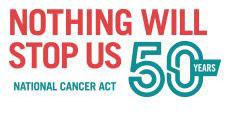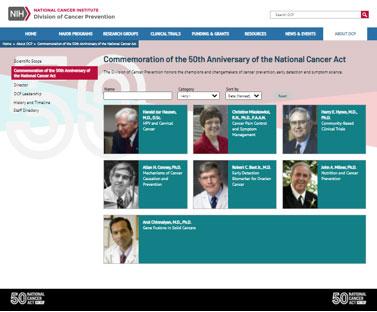Date Posted, by Philip E. Castle, Ph.D., M.P.H.
For centuries, visionary physicians have stressed preventing disease as the best option. I frequently say that the “best” cancer is the cancer that never happens. Today, we turn our attentions to the scientists who made stride after stride during the last 50 years to shape cancer prevention research.

Fifty years ago, the National Cancer Act was signed into law, kick-starting research that has changed how cancer is prevented, detected, diagnosed, treated, and survived, and moving us closer to a time when no one dies of cancer.
For prevention researchers and the NCI Division of Cancer Prevention, our aim is eliminating hundreds of related diseases called “cancer.” We know that preventing cancer can save millions of lives and help millions more people live healthier, longer lives. We know that identifying who is at risk for cancer can help us intervene to stop cancer from developing.
However, for now, people will continue to get the bad news, “You have cancer.” At this moment too, the research we support plays a key role. We know that earlier detection of cancer may allow treatments to work better. And we firmly believe that people who are treated for cancer should be free from any suffering caused by the disease or the treatment.
All of these goals must be reached through rigorous and innovative research that is applied to improve the health of all people. Cancer is a devasting disease that impacts everyone: the patient, their families, the communities in which they live and work, our nation, and the world. We must continue to make progress. Nothing will stop us (from preventing cancer).
In this 50th year of the National Cancer Act, DCP will honor the champions and changemakers of prevention, detection, and supportive care science by highlighting their achievements. When we brainstormed who should be included among the individuals who gave years of their lives and work to ending cancer, we came up with more names than we could feature in one year.
So, we chose some, but not all, of the scientists who made fundamental differences in cancer research and cancer care in these areas. They represent the farsighted, adaptable, esteemed, and often tenacious investigators who laid the groundwork for where the research goes next. These scientists, whose seminal work we will feature in the coming year, are a crucial part of the full story of the National Cancer Act.

We recognize the scientists and the research advances to which they contributed for a simple reason: for too many people, the idea of preventing cancer seems a faraway goal, but we know that cancer prevention is already within our grasp.
Since 1971, we not only determined that cervical cancer was caused by the human papillomaviruses (HPV), but we’ve created a vaccine to prevent infection by the virus. HPV infection is also linked to five additional cancers. If every child was vaccinated around the age of 12 years, this one vaccine would prevent more than 32,000 cases of cancer in men and women in the U.S. each year.
Since 1971, researchers went from using family trees to find hereditary cancer syndromes to genetic testing for mutations that increase risk for breast, colon, and other cancers. Identifying the genetic changes that increase cancer risk in these families has allowed us both to find agents to reduce risk and to discover where these molecular changes mirrored in cancer are seen in people without hereditary risk.
In 1971, the only cancer screening test available was the Pap test for finding cervical cancer. Now, we screen mid-adult women for HPV, a more effective way to prevent cervical cancer than Pap. Mammography became common in the late 1970s, on X-ray film; that technology has since changed to a digital one, where the computing power of artificial intelligence can be put to work. Today, we have reliable tests for finding colorectal cancer at early stages, some based on molecular testing, and two which let us remove the growths that precede cancer, thereby preventing the disease. And now people at increased risk of lung cancer due to their smoking history can reduce their chance of dying when screened with spiral CT.
In 1971, clinical trials to treat cancer only happened in large teaching hospitals and cancer centers. In the 1980s, this division moved cancer trials out into the community where successful therapies are quickly adopted by the investigators who have taken part in the trials. By supporting that creation of a national community oncology research network, today we know that the rigor of clinical trials is maintained in the community setting, where people actually live.
In 1971, people simply hoped to survive their cancer. Now, people with cancer are receiving less extensive surgery, carefully curated doses of anti-cancer drugs, and precisely focused radiation treatments. These efforts both effectively treat the cancer and preserve the well-being of the patient. Today, we also are beginning to understand the precise molecular basis of some of the worst side effects of cancer and its treatment, from nausea and pain to peripheral neuropathies and heart damage. As we move forward with the ground-breaking research that is changing lives for the better, we know we stand on the shoulders of giants. We hope that bringing them and their achievements into the light reveals the critical role of cancer prevention across the spectrum of the disease.
We congratulate and thank our cancer prevention heroes, heralded and unheralded, for their important contributions.
If you would like to reproduce some or all of this content, see Reuse of NCI Information for guidance about copyright and permissions. Please credit the National Cancer Institute as the source and link directly to the blog post using the original title, for example: "Standing on the Shoulders of Giants: Honoring the Scientists who Shaped Cancer Prevention Research During the Last 50 Years was originally published by the National Cancer Institute." For questions, contact us at CancerPreventionBlog@mail.nih.gov.
